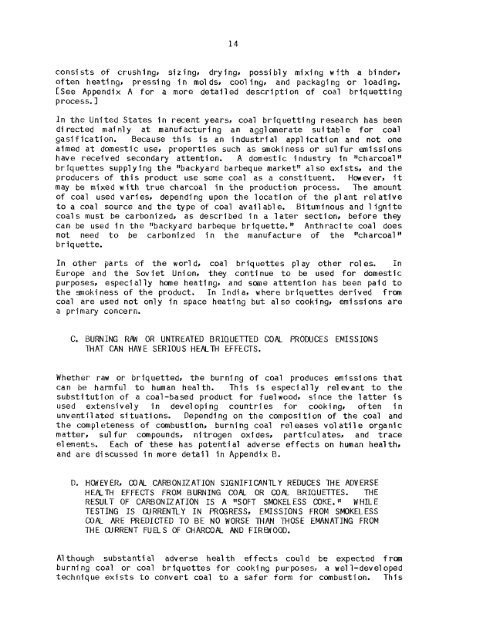Prospects for Coal Briquettes as a Substitute Fuel for Wood and ...
Prospects for Coal Briquettes as a Substitute Fuel for Wood and ...
Prospects for Coal Briquettes as a Substitute Fuel for Wood and ...
You also want an ePaper? Increase the reach of your titles
YUMPU automatically turns print PDFs into web optimized ePapers that Google loves.
14<br />
consists of crushing, sizing, drying, poss-ibly mixing wfth a binder,<br />
often heating, pressing in molds, cool ing, <strong>and</strong> packagdng or loadlng.<br />
[See Appendix A <strong>for</strong> a more detailed description of coal briquetting<br />
process. 1<br />
In the United States in recent yearsp coal briquetting research h<strong>as</strong> been<br />
di rected mai nl y at manufacturing an aggl ornerate sui tab1 e <strong>for</strong> coal<br />
g<strong>as</strong>ification. Because this is an industrial application <strong>and</strong> not one<br />
aimed at domestic user properties such <strong>as</strong> mokiness or sulfur emissions<br />
have rece?ved secondary attention. A domestic 1 ndustry in %charcoal It<br />
briquettes supplying the “backyard barbeque market9! al so exists, <strong>and</strong> the<br />
producers of this product use some coal <strong>as</strong> a csnstltuent. However, it<br />
may be mixed with true charcoal in the production process. The amount<br />
of coal used varies, depending upon the location of the plant relative<br />
to a coal source <strong>and</strong> the type of coal available. Bituminous <strong>and</strong> 1 ignite<br />
coals must be carbonized, <strong>as</strong> described In a later section, be<strong>for</strong>e they<br />
can be used in the ?!backyard barbeque briquette.” Anthracite coal does<br />
not need to be carbonized in the manufacture of the Ifcharcoalst<br />
briquette.<br />
In other parts of the world, coal briquettes play other roles. In<br />
Europe <strong>and</strong> the Soviet Union, they continue to be used <strong>for</strong> domestic<br />
purposesI especially home heating$ <strong>and</strong> some attention h<strong>as</strong> been paid to<br />
the smokiness of the product. In India, where briquettes ders’vec! frm<br />
coal are used not only in space heating but a1 SO coaki ng, emissions are<br />
a primary concern.<br />
C. BURNING R N OR UNTREATED BRIQUETTED COAL PRODUCES EMISSIONS<br />
7HAT CAN HAVE SERIOUS HEALTH EFFECTS.<br />
Whether raw or briquetted, the burning of coal produces emissions that<br />
can be harmful to human health. This is especially relevant to the<br />
substitution of a coal-b<strong>as</strong>ed product <strong>for</strong> fuelwaoch since the latter is<br />
used extensively in developing countries <strong>for</strong> cooking, often in<br />
unventll ated situations. Depending on the composition of the coal <strong>and</strong><br />
the compl eteness of combusti on, burning coal re1 e<strong>as</strong>es vol atil e organ1 c<br />
matter, sul fur compoundsp nitrogen oxide5, particul ates, <strong>and</strong> trace<br />
elements. Each of these h<strong>as</strong> potential adverse effects on human health,<br />
<strong>and</strong> are discussed in more detail in Appendix B.<br />
EVER8 COAL CARBONIZATION SIGNIFICANTLY REDUCES ME ADVERSE<br />
HEALTI1 EFFECTS FROM BURNING COAL OR COAL BRIQUETTES. THE<br />
RESULT OF CARBONIZATION IS A 50FT SMOKELESS COKE. Is WHILE<br />
TESTING IS CURRENTLY IN PR(XRESS9 EMISSIONS FROM SMOKELESS<br />
COAL ARE REDICTED TO BE NO WORSE WAN THOSE EMANATING FROM<br />
THE CURRENT FUELS OF CHARCOAL AND FIRENO0D.<br />
A1 though substanti a1 adverse heal th effects coul d be expected f ran<br />
burning coal or coal briquettes <strong>for</strong> cooki ng purposes~ a we1 l-devel oped<br />
technique exists to convert coal to a safer <strong>for</strong>m <strong>for</strong> combustion. This

















